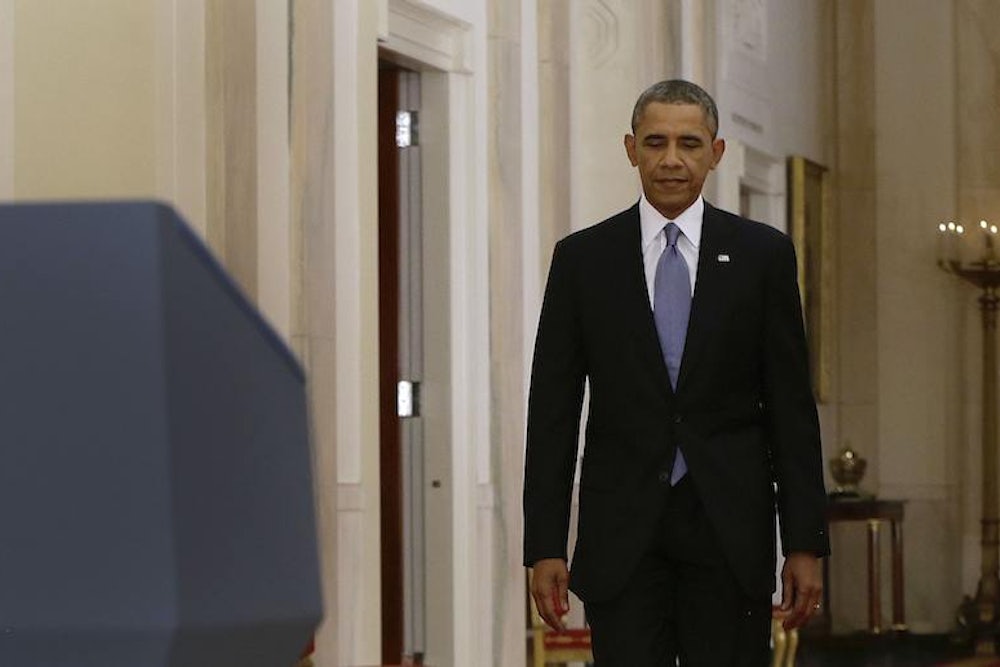When the president of the United States plans a military strike, the received wisdom says he is supposed to address the nation to tell us about it. We all have memories of gathering round the TV as presidents loved and hated (or in most cases, both) assured us that whatever long-expected military action was now underway, tidily, resolutely, and only because there was no other choice. But these ritual appearances usually fail to bring us closer to national consensus; they also tend to earn the White House poor reviews. In the case of President Obama, so often vaunted as a breakthrough speechmaker, it’s as if he whiffed on a homerun pitch.
Sure enough, the chilly reaction pieces to his Syria address are rolling in this morning. There are certainly some obvious reasons why the speech was probably doomed from the start—neither the public nor Congress has been at all keen on a strike, and the whole operation is now being held up as the putative Russia deal works itself out. But even so, it’s worth pointing out that for his many verbal talents, Obama has always been surprisingly bad at the direct-to-camera format.
When Obama squares to the lens, he seems to lose grasp of the energy that makes him an engaging speaker at other times. He may be able to melt a crowd with an Al Green line, but when he addresses us directly through the screen, he is nearly always flat and lifeless. This has been true since his earliest campaign ads in 2007, when he appeared in some kind of abstracted condo space to deliver a message of empowerment, and it is even more clear in the video address he records each week from the White House. There is something about the arrangement that—for me, at least—draws out more of a midwestern accent and makes him land heavily on his L's. He struggles at times with the pacing; the words tend to pile up in the wrong places. Thanks to the miracle of HD, you can see his eyes moving along with the teleprompter, and it’s distracting.
Last night’s speech was well written and pretty well delivered, especially under the circumstances. Obama was periodically animated and engaging, particularly when he urged viewers to seek out the video evidence of the gas attacks. But still, the deadening trappings of the presentation were everywhere. He swiveled his head slightly from side to side, as if he were sitting for a three-quarters-view portrait, often synchronizing the head movements with unconvincing fist-shakes. The camera lights shone brightly in his eyes. As he passed from the horrors of Sarin to a major transition line—“Let me explain why.”—he had reached the speech’s persuasive dead-lift, and the strain showed. Most of all, the empty corridor behind him, with its vacant chairs and grim candelabra, deepened the sense of isolation, the certainty that this was a man trapped and alone in his argument. It hardly looked to be the same backdrop as when Obama announced that we’d nabbed bin Laden—though re-watching the tape, it was an awkward setup even then. Something about that lonely walk back down the hall.
Recently I argued that the White House should do away with the press secretary's daily briefing and replace it, in part, with more appearances by the president himself in front of the press corps. I stand by that prescription. Obama is at his best when he is in front of an active audience, not just the adoring crowds of the campaign trail, but leery journalists, too, or even openly hostile opponents. I’ve always thought that his live Q&A at the House Republican retreat in 2011, while the health care push was in free-fall, was Obama’s most commanding performance as president. When, a year later, he completed his evolution on same-sex marriage, he didn’t request airtime from the networks for a to-camera speech, or give a speech at all: He sat down with ABC’s Robin Roberts and explained his change of heart by way of a conversation. It looked much more normal. Even Obama’s interviews with network anchors about Syria—totally absent the sense of relief that accompanied the gay marriage announcement—were lively and comfortable, far more effective than the East Room address. The president is better at explaining when he has a question to play off of. And someone else to look at.
For the next big announcement—if we end up launching a strike, say—the White House should consider scrapping the turbid direct address and doing a live town hall instead, or even better, sending Obama to the House of Representatives to defend his decision, live in primetime. (There’s a reason everyone loves watching the Prime Minister’s Questions.) He’d get to deflect the heat back onto his opponents, a time-honored technique and more than fair play for a Congress that seems only to want to say no to things. The president might not change any minds, but then again, a good part of the opposition to Obama’s Syria plan seems to be opposition to Obama himself. He might as well get the credit for handling the counterarguments. And besides, it would be better television.
Reid Cherlin, a former White House assistant press secretary, is a writer living in Brooklyn.
